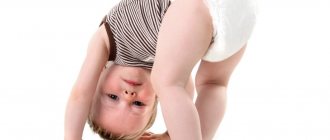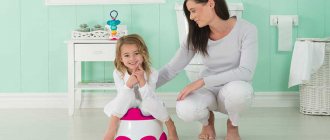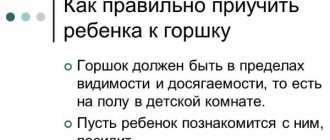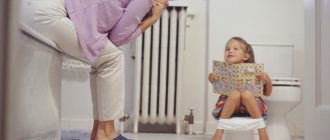Potty training a child must take into account certain rules. It is important to correctly determine at what age the baby needs this, as well as the method that will be used in the process of learning a new skill. All parents strive to make this process as simple as possible for their child, and there are some techniques for this. Mistakes in the process of potty training a child later lead to serious difficulties, which can result in fears and complexes.
Parents' mistakes in this process
When talking about how to potty train a child, it’s worth starting with the mistakes that are very often made in this process. They not only significantly complicate and lengthen the period of mastering the skill, but in some cases they can cause a deterioration in the psychological (not to be confused with mental) state of the child. In total, there are 5 main parental mistakes that do not allow the baby to grow up in a short time regarding the toilet.
- Wrong age. You need to know exactly what time to potty train your child. If you start training too early, then at best the baby will develop a reflex to the words of his parents at the moment when he is put on the potty. There are no conscious actions or control over your body at this time. The correct age to start training is 14 months. The body is already sufficiently formed to control the processes of urination and defecation.
- Excessive use of diapers. If the baby is constantly in diapers, and suddenly the parents suddenly remove them, difficulties immediately arise. For a long time, the child cannot understand the need to endure and sit on the potty. If a baby constantly sleeps in a diaper, then until the age of 4 he will experience the need to urinate at night and will not necessarily wake up at this moment. If parents do not abuse diapers. and the baby spends most of his time without them, then already at 2 years old the problem with the toilet does not arise at night.
- Excessive persistence. When a person, regardless of his age, is under constant pressure, he begins to reject what is offered to him. You cannot constantly put your baby on the potty and not allow him to leave it until he does what is required of him. Also, suggestions that the child can only go to the toilet to go potty will only be detrimental to the child.
- Punishments for wet pants. Parents often believe that if a child is punished for going to the potty rather than in his pants, he will sooner understand what is required of him and will stop making mistakes. In reality, this is a direct path to complexes, phobias, low self-esteem and childhood depression. To speed up the potty training process, it would be more correct to involve the baby in cleaning up the consequences, while at the same time unobtrusively explaining that if he went to the potty, he wouldn’t have to clean up, which means there would be more time for play.
- Excessive attention to going to the potty. If there is constant fuss around the baby about the right place for the toilet, he will gradually begin to get tired of it and, as a sign of protest, will begin to leave surprises in inappropriate places.
Knowing the possible mistakes makes potty training a child much easier. Avoiding the wrong approach to solving a problem is not so difficult, and then, having learned to use the item, the child will no longer forget what it is for.
All the most important things about the Potty: practical TOILET-POTTY CHILDHOOD
The topic of the toilet is intimate, reverent, undeservedly pushed aside in importance. Even taboo. (And in our chapter there will be a lot of “bodily” words and descriptions of physiological processes) Analysts associate the time of potty training (1-3 years) with the development of creativity, speech, neatness and disgust, greed and wastefulness... And it is precisely with the child’s potty training parents have many questions, disputes, frustrations. And, really, we know many adults who find it difficult to go to the toilet in an unfamiliar place? And, really, many kids who go to kindergarten or school suffer with all human strength - do not go to the local toilet in order to wait until they come home? If their concentration of attention is aimed at holding something back, “not letting it out,” it is logical that they will not have time for the opposite action - concentration on “receiving, absorbing” knowledge, learning songs or games. Any muscle tension in one place leads to tension in others.... There is such an interesting sign - we can say that a child has adapted to a certain place if he eats and poops there.
When my parents and I talk about how to help our child get ready for school, one of the first points is to go to the school toilet. 1. Find out its location. 2 If this establishment is of an unusual design, look for similar ones in the city and get used to using it. The body level is basic for all of us. Regardless of age, social status, education. We live in a body. And our brain, our emotions and our spirit “live” in it; if this “house” of ours is uncomfortable, all other levels will not feel good
When we start “potty training.” Please do not believe those who insist on a specific age. And don't compare your baby with your neighbors. Each child has his own readiness. Some will be ready to take off diapers at 9 months, others closer to 3 years.
Rules that always have exceptions - Children of the “diaper generation” master potty life later; the second children in the family sit on the potty earlier than the first-born. - girls, who more easily master “social behavior”, sit on the potty earlier than boys. – whenever parents start teaching... The child will sit on the potty when he is ready, but there is evidence that for children whose parents started potty training very early, the process may take longer.
We take with us into the practice of “potty taming” patience and tolerance, confidence that we are good parents of a wonderful child, the ability not to compare ourselves and our children with other parents and other children, the ability to calmly listen to criticism and advice from grandparents, feeling humor, the ability to wait, the desire and strength to support the baby... and the ability to start all over again with a smile, and the necessary knowledge:
– Until about 18 months, most children do not know how to control the muscles of the rectum and bladder. By about 3 years of age they already have this skill. Known to all of us, “the anal phase of development according to Freud - (from 1 year to 3 years) - is associated with the pleasant sensations received by the child during the excretory activity of the colon and bladder” - i.e. The child enjoys the fact that he can control these actions.
– as a rule, at first babies learn control in the following sequence: pooping - (defecation) control of the intestinal muscles - at night, defecation - during the day, peeing - urination - during the day, urination - at night.
– the child CONSCIOUSLY sits on the potty when the word “I” appears in his speech.
– many boys first begin to pee on the potty while sitting, then master the “vertical” urination position (more on this later)
The ideal time for training is, of course, summer. But if we can provide warmth to the baby, if the child and we are ready, then “right” – any time
The likelihood that the baby is ready to “conquer the potty”:
– he learned to sit, walk, squat
– he has regular formed stools
– gets up dry after a nap and can stay dry for 3-4 hours
- makes sounds - which you taught him, or invents his own, when he wants to pee or poop - grunts, says “ah-ah” and so on, crouches, tries to take off diapers or panties, says “pee” - “poop”.
– the child begins to imitate your actions. He watches how you go to the toilet, he is interested in the potty, he tries to take off and put on clothes himself.
– feels uncomfortable in wet and dirty clothes or a diaper
– at the time of potty training, the child does not experience a crisis of resistance
Until this time, we voice the child’s actions - “you peed”, “ah-ah” or what is customary in your family, after a day-night sleep we “catch” the beginning of the pee, you can hold the child (if the child has not yet mastered sitting - we simply hold it comfortably over a bathtub or some container), naming it and voicing its important action. And we wait for readiness
Parent training. – We agree on a strategy and synchronize actions and expectations
- Let's be patient
– For 2 weeks, write down when your baby poops and pees (this will make it easier for you to “guess” the time to ask your baby to sit on the potty)
– We prepare comfortable clothes that can be taken off quickly and easily. Better - clothes with Velcro
– We stock up on oilcloths, napkins, paper
– we look on the Internet and magazines for photos or pictures of children sitting on the potty. If you find a book with pictures about this, that’s absolutely great (share the information with me, please, I haven’t seen such Russian-language books - Ukrainian-language ones). And we unobtrusively look at pictures and books. You can hang such a picture above the place where the pot will “live” in the room.
- We buy a pot.
The pot must be stable. The pot must match the size of the bud. If the baby is cramped, or the butt falls into the “container”, the child will be unsafe and in pain. The material from which the potty is made should be pleasant. The potty should not cause discomfort. It is advisable that the pot does not make sounds. (Musical potties are popular now.) Do not buy a potty that looks like a car seat or baby chair (I know children who associated the potty with these objects. Every time they got into the car, the baby pooped. Do not buy a too bright “toy” potty. The child is everything He will play with them just the same, but it is still important for us that another purpose is fixed in the mind. When sitting on a potty, on a toilet seat, it is important for a child to reach with his feet to the floor. (We put a stand under the legs)
“TAMING”
– All our actions are clear, but smooth. With a smile. No tension. No violence. We respect the child's pace and readiness.
– First, we plant our favorite toy on the potty. (The toy can “get used” to the potty for about a week). Over time, you can invent your own potty for the toy, so that he and the baby are in the “process” at the same time.
– Then we sit down with our clothes on and laugh ourselves (the child must make sure that it is safe).
– then we invite the child to sit in his clothes on the potty
– then, we plant the “bare-bottomed” baby after sleep or after eating
– THE POT SHOULD BE AT A COMFORTABLE TEMPERATURE. A warm butt, touching a cold pot, spasms. And he won’t want to sit on it anymore.
– you can try to put the child on the potty in a diaper, and then take off the diaper right on the potty.
– if the child has resistance, we stop the actions. And every other day we do another “approach to the projectile”
- if the baby still poops in the diaper, you can remove the diaper and pour the “contents” into the potty. Many kids are afraid of the toilet, they think, “if this thing absorbs what comes out of me, it can absorb me too.”
– keep the potty nearby, inviting the child to use it, reminding him before going for a walk and going to bed
! Every time a child is able to use the potty, we rejoice and support him. Words, hugs! ! If the child doesn’t have time to go to the potty, we don’t scold him, we support him, we wait patiently! ! Any changes - illness, stress, moving... - can cause regression in mastering not only the potty, but also other skills! ! After each visit to the toilet, we teach boys and girls to wash their hands!
Unclassified secrets - most often children pee immediately after sleep, poop after breakfast
– as a rule, the child wants to poop 20-30 minutes after eating (a full tummy stimulates the rectum to empty). You can put your child on the potty after every meal and after sleep
– keep the pot nearby, in a convenient place
– if the child is already asking to use the potty, if he has learned to use it himself, then using diapers again is not correct and even dangerous.
– the pot is an extension of the house. If you are going to the country, to your grandparents, or moving, take an already “tamed” pot with you. This will make it easier for the child to adapt to the new place.
- during the “crisis of resistance” - refusing to use the potty, pooping and peeing in your pants and on the carpets - one of the forms of living the crisis (see the chapter on the “three-year crisis”.
Unclassified secrets for boys
– boys, as a rule, begin to master the potty – sitting, then standing :-))
– the process of emptying the bladder and bowel often occurs simultaneously. Therefore, it will be easier for the child to “concentrate” on both processes while sitting.
– each boy has his own pace of transition from “sitting” to “standing.”
– the child “mirrors” the actions of adults. When a baby sees an authoritative dad peeing while standing, he himself tries to master this skill
- in order to encourage a boy to pee while standing, to “optimize” the process into a more accurate one, you can motivate to pee on the street - at home: throw toilet paper into the toilet, stick a sticker or adhesive paper on the inner wall of the toilet - like a target for the baby to hit hit; suggest that the boy pee on the street, directing the stream onto a stone or leaf.
I am sure that you will rejoice at your child’s successes and achievements!
IMPORTANT about constipation, greed, creativity, the ability to let go
- at one of the receptions, a 4-year-old boy - “Aunt Sveta, I love you so much, I love you so much that I’ll cut you into pieces, eat it and... not poop it out” one of the best compliments
No matter how strange it may seem to us, “poop” is our child’s first work of art. He proudly brings the pot - right to our eyes and noses, with a beaming face or with the words - look what it looks like. He paints the walls, the floor, himself with the contents of the pot... If our reaction is disgust, and the word “ew”, then the cub will take this “fu” personally. A poop in a pot is a drawing, a sculpture is a child’s first masterpiece. Our task is to say something supportive - joyful and praise the child for mastering the potty. otherwise, we damage the child’s creative potential, his self-esteem. And we let him understand that what “comes out” of him is bad and shameful. This means that he himself is bad... But words, and drawings, and all kinds of aspirations for development “come out” of him. Imagine, with our careless reaction we can provoke stuttering, constipation, and refusal to express creativity. And we provoke increased disgust in the child.
Feces are generally a multi-level “image”. You and I remember that a child’s world is dad and mom. The baby, only having been filled with parents, “swallowing them”, satiated with their love, can then let them go. (And in the future he will be able to create close relationships and let go of loved ones). If a child has the feeling that his parents are slipping away, that they can disappear somewhere at any moment - emotionally, physically - the child on an emotional level becomes either “clingy” or detached, and on a somatic level he may experience constipation or encopresis (pumping) . Imagine that in a strange internal projection, parents are “poop”. “If I know that they are always nearby when needed, I can let them go and “poop out.” If they keep slipping away - I can’t hold them - I will either relax the sphincter muscles or squeeze them - that’s one of the reasons for encopresis and neurotic constipation.” When they come to my appointment with a request - a child has constipation - the first question I ask is - who can the child be afraid of losing? Who does he miss? It’s interesting that the “squeezing” inside parents - and parents are the source of life - is transferred to many “sources” - toys, and then - money, relationships, resources.. And we see the manifestation of such “constipation” and “pumping” in greed or wastefulness….. We sometimes say “I “pooped” (wasted) money” (time, chance)… And children’s therapy will be closer physical contact, our words “I’m with you”, releasing balloons , blowing soap bubbles, and, of course, it is important to give the child the opportunity to be filled with the parent as much as he needs. Give a feeling of closeness. For example, before going to bed, put the baby in your arms (tummy to tummy) and sit there until the baby wants to get off. Our task is to try to give more than what is asked of us.
In my 13 years of practice, there was only one child who did not master the potty. But this was a pathological and exceptional case. “They will all sit on the potty,” we can say with a phrase from our favorite movie.
At the end of the chapter, I’ll tell you about the secret I learned about from my Teacher, Mark Vladimirovich Voronov. It's called "Mom's Plot." We know that mom and dad can do much more for a child than all possible specialists. The time when the baby falls asleep (“drowsy state”) is equated to a magical - trance-hypnotic one. The information that the child perceives goes unhindered into the subconscious. It is important that we ourselves are calm, it is important that we are not in a hurry, our hand lies on the child’s navel, we speak quite quietly, sincerely, phrases that we will write down in advance, all phrases without particles “not”... The text itself - each of you will write your own. The topic depends on what is important for you to transform. Example: “I am with you. I love you and am glad that I have you. When you want to pee (poop), you will call me or sit on the potty (or - you are safe, or - every day you master more and more words and your speech is more and more fluent, without hesitation or ... I'm glad I'm having a girl (boy) (this is important if during pregnancy you were strongly expecting a child of a different gender) dad (mom) and I love you.”
All processes in our growing up and our lives are equally important. And we pay as much attention to the potty as we do to food, health, development, and sexuality. It is desirable that we do not have taboo or “indecent” topics.
Healthy, easy, harmonious, interesting learning for your families of different adults. Let all processes go smoothly
Svetlana Roiz, child and family psychologist, author of the books “The Magic Wand for Parents”, “Where the Angel Lives”, mother, aunt, godmother, rejoicing in all facets of children growing up.
The right pot
Choosing a potty is a responsible task, since if the item is chosen incorrectly, it may happen that training to it will be impossible. The main selection criteria are:
- shape - depending on the gender of the child, choose the shape of the potty: girls will be more comfortable with round ones, and boys with oval ones;
- material – it is important that the chosen model is not cold. If you sit the baby on cold material, then the training will be a complete failure the first time;
- stability - the baby will not sit on a shaky potty. If a child falls from the potty or with it, then in the future you may be faced with a complete refusal to use the item;
- lack of musical accompaniment or lighting - any entertaining moments will turn an object into a toy for the baby, and potty training a child as a toilet will be extremely difficult, and sometimes impossible for a long time;
- presence of a lid - if you plan to use the pot only at home, then a lid is not required. When you plan to take the children's toilet with you, the lid will come in handy;
- a backrest – it will be very useful, as it will add stability to the child and minimize the risk of falling. It is especially important to have back support for babies who are highly mobile.
When you need to potty train a child, you need to approach the choice responsibly. The offer today is very large, and parents will always be able to choose the ideal option for their baby.
Read more about how to choose the right pot
General rules of training
There are general recommendations for potty training a small child. They allow you to teach your child how to use an object as quickly as possible without developing negative reactions. Parents need to be patient enough, as they won’t be able to achieve results the first time.
- When showing a child a potty for the first time, you should not force him to sit on it. If there are older children in the family, they will be able to set an example for the baby. If they are not there, then first they put a doll or other toy on the toilet and tell the baby what the thing is for and why it is so good.
- It is worth explaining that being wet and dirty is very unpleasant, and by using a potty you can avoid this.
- When the baby manages to do everything correctly, he needs to be encouraged, but at the same time not make a fuss around him. If your pants turn out to be wet, then, without scolding your baby, you need to remind him that there is a potty that allows you to miraculously remain dry and clean.
- The potty should be positioned so that the baby can reach it himself. This is important, because otherwise the child will regularly forget about the item and get his clothes dirty.
- It is necessary to explain to the baby what the object is for, and gently remind him that it may be time to sit on it. It is especially important to do this after eating and sleeping.
- It is necessary to sit on the potty at the time when the child may approximately need to go to the toilet. This will allow him not to forget about the needs of the body and get used to having time to get to the potty.
If the child is very nervous while on the potty, then you need to buy a toy or a book with bright pictures, which will be given to the baby only at this time. Such an incentive will help overcome the fear of the object, and a pleasant activity will calm the child while he is on the potty. Knowing how to potty train a child, a mother can calmly cope with the task.
Training methods
There are several methods that explain how to quickly potty train a child. The choice of a specific one remains with the parents, who must take into account the individual characteristics of their baby.
During the week
A method that helps solve a problem in a week is suitable in most cases. This is the fastest method that can be used to part with diapers.
- The first day. As soon as the baby wakes up, you need to take off the diaper and explain to the child that he is big and can already wear panties. After this, you need to immediately put him on the potty. If the baby just can’t figure out what they want from him, the mother can take him with her to the toilet and explain, using her own example, what needs to be done. The child should spend 10 minutes on the potty in the morning, as this time is enough for all physiological needs.
- Second day. We need to consolidate the skill. At the same time, it is important for the mother to ensure that the child does not play too much, as this will not allow him to remember the skill.
- Day three. The child should not be in diapers even during a long walk, as this will only confuse him. The mother should regularly ask her baby if he needs to go to the toilet. If it turns out that you need a potty, then you need to relieve yourself in the bushes. If you have the opportunity to take a potty with you, then this would be an ideal option.
- From the 4th day, the mother will be able to approximately determine at what intervals the baby needs to go to the toilet, and promptly remind about the need to use the item. If the trip to him is successful, the baby deserves praise. Usually by the end of the 7th day the skill is firmly established.
In 3 days
This technique is not suitable for all children, and there are also cases that after several days of proper toileting, the panties end up wet again. The best age to start potty training your child using this method is 18 months. Such a baby is already able to fully control the processes of defecation and urination.
Your child should be prepared to use the potty about a week in advance. To do this, you should regularly tell him (but not intrusively) what a good thing it is and how to use it. It must also be said that soon the baby will walk like an adult, in shorts, and not a diaper. Good for an incentive to buy panties that have images of your favorite cartoon characters on them.
Direct training should begin at a time when there are at least 3 days that can be completely devoted to the child.
- First day. At this time, the baby should get used to walking without a diaper. At the discretion of the mother, the baby is put on underpants or allowed to spend the whole day naked if the temperature at home is comfortable. The mother must constantly monitor the child, always having a potty at hand. As soon as the baby begins to urinate or defecate, he is immediately seated on the potty. It is very important that during the day every urge to go to the toilet is accompanied by sitting on the potty. If you miss even once, the connection between actions will not be developed. After each successful use of the potty, the child should be praised, explaining why. You should not walk throughout the entire first day of training.
- On the second day in the house everything happens the same way, but you can go out for a walk - and without a diaper. The walk should be immediately after the baby has gone to the toilet. It wouldn’t hurt to take a potty with you when going outside.
- 3On day 3 you need to go for walks 2 times. This will allow the baby to learn to endure. If possible, we should try to make him wait until he gets home. If this is not possible, you should relieve yourself on the street, but at the same time say that at home this is done on the potty.
Children do not always immediately understand that when sitting on the potty, they need to take off their panties. You shouldn’t scold for this, but you just need to calmly explain that pants and panties are taken off over and over again. It will also be useful to remind your baby of this before going to the potty.
These two methods, aimed at properly potty training a child, are the most popular and comfortable for the baby. There are many more developments regarding the toilet problem, and if you wish, you can learn a variety of methods.
Is it harmful to sit on the potty for a long time?
Answered by Komarovsky E. O.
Direct and specific answer: not harmful.
Now the details. The details are clear to everyone, but we just need to dot the i’s and close the topic.
The main question: why does the child sit on the potty (optionally, the toilet)? Right! In order to relieve the need that has arisen (in situations where prolonged sitting is discussed, we are usually talking about a great need).
The process of defecation itself can be extended over time and require quite a certain amount of effort. And for us (adults) it is very important to understand: what exactly is a child doing sitting on the potty?
Imagine a red child sitting for 10 minutes with bulging eyes, unsuccessfully trying to fill the pot. It is clear that this is abnormal, harmful, and takes a long time. And 10 minutes is long, and 5, and even 3. Fissures and hemorrhoids are possible, but nothing falls out anywhere, since rectal prolapse is a condition associated with various anatomical defects. That is, if a child was born without specific anatomical defects, he can sit on the potty for hours and days, but he will not be able to sit through rectal prolapse.
A condition in which rare, incomplete or (which is important in our case) difficult bowel movements occurs is called constipation. Constipation is treated by doctors; there are very specific recommendations, diets, and medications.
Therefore, if a child sits on the potty for a long time because he cannot empty his bowels, we consult a doctor and treat constipation.
It should be recognized that in most cases, when a child sits on the potty for a long time, he simply likes to sit on the potty .
In other words, sitting on the potty is a pleasant way of spending time for a child, often characterized by the fact that the child, carried away by this activity, forgets why he sat on the potty in the first place.
It is impossible to analyze children's behavior in isolation from the behavior of adult family members. After all, if dad can occupy the toilet for 2 hours, why doesn’t the child have the right to do so? Children, as we know, copy the behavior of adults, so the opportunity to remain alone for a long time in the toilet room with their favorite gadget is often considered by the child as a real mechanism for introducing them to the world of mom and dad. It is not surprising that for many children, communicating with the potty (optionally, the toilet) turns into a kind of ritual. Moreover, there is a ritual for which you need to prepare - take with you the necessary toys, a book, a phone and have a good time, be no worse than mom and dad.
The main recommendation: before scolding a child for staying on the potty for a long time, think about how this process is implemented in relation to adult family members.
Just honestly answer the question for yourself: how long is it on the potty? Is it possible to play, read, watch cartoons while sitting on the potty, or is the potty designed solely to quickly fulfill physiological needs and forget about them? All answers











